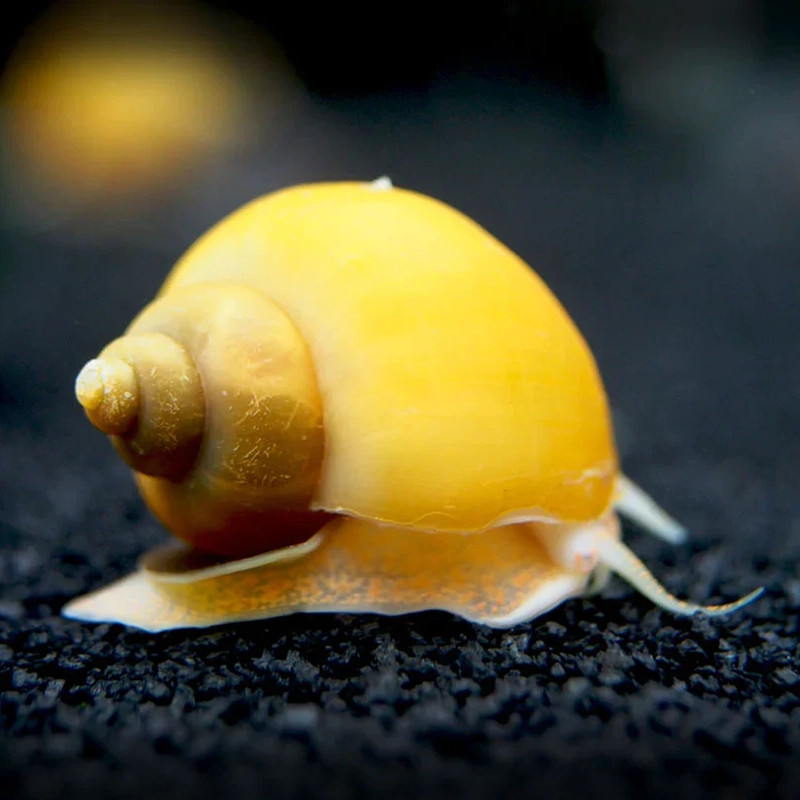Stocks Available
Mystery Black Snail
SKU:116438
POMACEA BRIDGESII
0.5 - 1.25 INCH

Stock Available
Introduction: Species: Pomacea bridgesii Common Names: Gold Mystery Snail, Golden Inca Snail Natural Habitat: Native to the slow-moving freshwater rivers, ponds, and wetlands of South America, particularly within the Amazon Basin. These snails are often found in shallow waters with abundant plant life. Physical Characteristics: Appearance: The Gold Mystery Snail is known for its vibrant golden-yellow shell, which adds a pop of color to any aquarium. Its body can be pale to dark brown or even black, offering a beautiful contrast with the bright, smooth, spiral shell. The snail's operculum allows it to seal itself inside its shell when threatened or during unfavorable water conditions. Size: Grows up to 2 inches (5 cm) in diameter. Lifespan: Typically 1-2 years with proper care. Habitat Requirements: Tank Size: A minimum of 5 gallons is recommended for each snail, but they will appreciate larger tanks for exploring. Water Conditions: Temperature: 68-84°F (20-29°C). pH: 7.0-8.4 (prefers slightly alkaline water to promote strong shell growth). Aquascaping: Provide a well-planted aquarium with soft substrates, ensuring that the snail has plenty of surfaces to explore and graze on. They also appreciate hiding spots such as rocks, driftwood, and dense plants. Mystery Snails require access to the water’s surface for air-breathing, so leave some space between the water line and the tank lid. Diet: Primary Diet: Herbivorous; in the wild, they consume algae, detritus, and plant material. Supplemental Feeding: In an aquarium, feed blanched vegetables (such as zucchini, spinach, or lettuce), algae wafers, and other calcium-rich foods to maintain healthy shell growth. They also help clean algae off tank surfaces. Feeding Frequency: Feed small amounts 2-3 times a week. Make sure to remove any uneaten food to maintain water quality. Compatibility: Temperament: Gold Mystery Snails are peaceful, non-aggressive, and slow-moving. They thrive in community tanks with other non-aggressive species. Suitable Tank Mates: They do well with small fish like Tetras, Guppies, Rasboras, and peaceful shrimp species like Amano or Cherry Shrimp. Incompatibilities: Avoid keeping them with aggressive or predatory species like Cichlids or Crayfish, which may harm the snails. Care Level: Difficulty: Easy; Gold Mystery Snails are hardy and adaptable, making them perfect for beginner aquarists. However, they are sensitive to poor water quality and need stable water parameters. Health Monitoring: Maintain a calcium-rich diet to ensure their shells stay strong. Look for signs of shell damage or erosion, which can indicate insufficient calcium or poor water quality. Regular water changes and monitoring for ammonia and nitrites are essential. Breeding: Breeding in Captivity: Gold Mystery Snails are easy to breed in home aquariums. Females lay clusters of eggs above the waterline, usually at night. Spawning: Eggs will hatch in 2-4 weeks depending on temperature. After hatching, baby snails can be fed a similar diet to adults, such as finely crushed flakes, blanched vegetables, and algae wafers. Economic Considerations: Market Demand: High demand for their attractive coloration and algae-eating abilities, making them a favorite among hobbyists. Wholesale/Retail Pricing: Gold Mystery Snails are readily available in the aquarium trade and are usually affordably priced. Sustainability and Conservation: Wild Population: Not considered at risk; they are abundant in the wild and frequently bred in captivity. Aquaculture Efforts: They are easily bred in captivity, which helps reduce pressure on wild populations. Regulations: Some regions have restrictions on non-native snails to prevent their spread in local ecosystems, so always follow local regulations. Conclusion: The Gold Mystery Snail is a striking and low-maintenance addition to any freshwater aquarium. With its vibrant golden shell and peaceful temperament, it’s a popular choice for both beginner and experienced aquarists. They not only add beauty to your tank but also contribute to keeping it clean by grazing on algae and plant debris. With proper care, these snails can thrive and add life and color to your aquarium for years.
Data sheet
16 other products in the same category:
Customers who bought this product also bought: